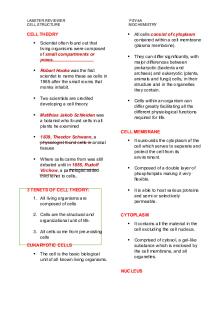Cell Structure SE - Summer AP Bio PDF

| Title | Cell Structure SE - Summer AP Bio |
|---|---|
| Author | Catified Animations |
| Course | Molecular Biology |
| Institution | Harvard University |
| Pages | 3 |
| File Size | 102.5 KB |
| File Type | |
| Total Downloads | 110 |
| Total Views | 186 |
Summary
Summer AP Bio...
Description
Name: ______________________________________ ________________________
Date:
Student Exploration: Cell Structure Vocabulary: cell membrane, cell wall, centriole, chloroplast, cytoplasm, endoplasmic reticulum, Golgi apparatus, lysosome, mitochondria, nuclear membrane, nucleolus, nucleus, organelle, plastid, ribosome, vacuole, vesicle Prior Knowledge Questions (Do these BEFORE using the Gizmo.) What are some of the structures inside a cell that help it to live and perform its role in an organism? Nucleus, cytoplasm, ribosomes, endoplasmic reticulum, and mitochondria. How do you think plant cells differ from animal cells? (Hint: What can plants do that animals cannot?) Plant cells typically have chloroplasts, which allow them to do photosynthesis. Gizmo Warm-up The Cell Structure Gizmo allows you to look at typical animal and plant cells under a microscope. On the ANIMAL CELL tab, click Sample to take a sample of an animal cell. Use the Zoom slider to see the cell at a magnification of 2000x (2000 times larger than normal). On the dropdown menu, select Centrioles. •
Use the up/down and left/right sliders to manipulate the cell. Find the red arrow pointing to the centrioles. Make a sketch of the centrioles in the space below.
Read the description of the centrioles. What is their function? They organize the movement of chromosomes during cell division. Activity A: Animal cells
Get the Gizmo ready: • Check that an Animal cell is mounted on the microscope. • Check that the Zoom is set to 2000x.
Question: Organelles are specialized structures that perform various functions in the cell. What are the functions of the organelles in an animal cell? •
Label: Locate each organelle in the animal cell. Label the organelles in the diagram below.
Top 3 (left to right) nucleolus, nuclear membrane, vacuole Left 5 (top to bottom) nucleus, cytoplasm, centrioles, golgi apparatus, ribosomes Right 5 (top to bottom) cell membrane, endoplasmic reticulum, lysosomes, vesicles, mitochondrion •
Match: Read about each organelle. Then match each organelle to its function/description. H Cytoplasm E Lysosome F Mitochondria A Centriole G Endoplasmic reticulum M Vacuole D Cell membrane J Nucleus L Ribosome C Nuclear membrane B Golgi apparatus K Vesicle I Nucleolus •
A - Structure that organizes motion of chromosomes.
•
B - Stack of membranes that packages chemicals.
•
C - Membrane that protects the nucleus.
•
D - Membrane that surrounds and protects the cell.
•
E - Sac filled with digestive chemicals.
•
F - Structures that convert nutrients to energy.
•
G - Passageways where chemicals are made.
•
H - Jelly-like substance within the cell membrane.
•
I - Structure that manufactures ribosomes.
•
J - Structure that contains DNA and regulates genes.
•
K - Package created by the Golgi apparatus.
•
L - Small structure that synthesizes proteins.
•
M - Sac that stores water, nutrients, or waste products.
Activity B: Plant cells
Get the Gizmo ready: • Select the PLANT CELL tab, and click Sample. • Set the Zoom to 2000x.
Question: What functions do the organelles in a plant cell perform? •
Label: Locate each organelle in the plant cell. Label the organelles in the diagram below.
4 Top (left to right) Endoplasmic reticulum, Nucleolus, Nuclear membrane, Nucleus 5 Left (top to bottom) Cell membrane, Cytoplasm, Cell wall, Chloroplast, Vacuole 5 Right (top to bottom) Mitochondrion, Golgi apparatus, Vesicles, Plastids, Ribosomes Compare: What structures are present in an animal cell, but not in a plant cell? Centrioles and lysosomes. What structures are present in a plant cell, but not in an animal cell? Cell wall, chloroplast, and plastids •
Fill in: Name the organelle or organelles that perform each of the following functions. •
Chloroplasts convert sunlight to chemical energy.
•
The cytoplasm and the cell wall help to support the plant cell and help it to
•
maintain its shape. Plastids store food or pigments.
•
The mitochondrion converts food into energy. It is found in both plant cells and animal cells....
Similar Free PDFs

Cell Division SE - Summer AP Bio
- 5 Pages

Cell Structure SE 1
- 3 Pages

Cell Division SE - bio
- 5 Pages

Cell Types SE - bio
- 9 Pages

Cell Energy SE - Bio
- 6 Pages

AP Bio Cell Cycle
- 3 Pages

Labster 1 cell structure
- 10 Pages

Cell Structure (reviewer)
- 7 Pages

Structure of generalized cell
- 2 Pages

Cell Structure Worksheet
- 1 Pages
Popular Institutions
- Tinajero National High School - Annex
- Politeknik Caltex Riau
- Yokohama City University
- SGT University
- University of Al-Qadisiyah
- Divine Word College of Vigan
- Techniek College Rotterdam
- Universidade de Santiago
- Universiti Teknologi MARA Cawangan Johor Kampus Pasir Gudang
- Poltekkes Kemenkes Yogyakarta
- Baguio City National High School
- Colegio san marcos
- preparatoria uno
- Centro de Bachillerato Tecnológico Industrial y de Servicios No. 107
- Dalian Maritime University
- Quang Trung Secondary School
- Colegio Tecnológico en Informática
- Corporación Regional de Educación Superior
- Grupo CEDVA
- Dar Al Uloom University
- Centro de Estudios Preuniversitarios de la Universidad Nacional de Ingeniería
- 上智大学
- Aakash International School, Nuna Majara
- San Felipe Neri Catholic School
- Kang Chiao International School - New Taipei City
- Misamis Occidental National High School
- Institución Educativa Escuela Normal Juan Ladrilleros
- Kolehiyo ng Pantukan
- Batanes State College
- Instituto Continental
- Sekolah Menengah Kejuruan Kesehatan Kaltara (Tarakan)
- Colegio de La Inmaculada Concepcion - Cebu





